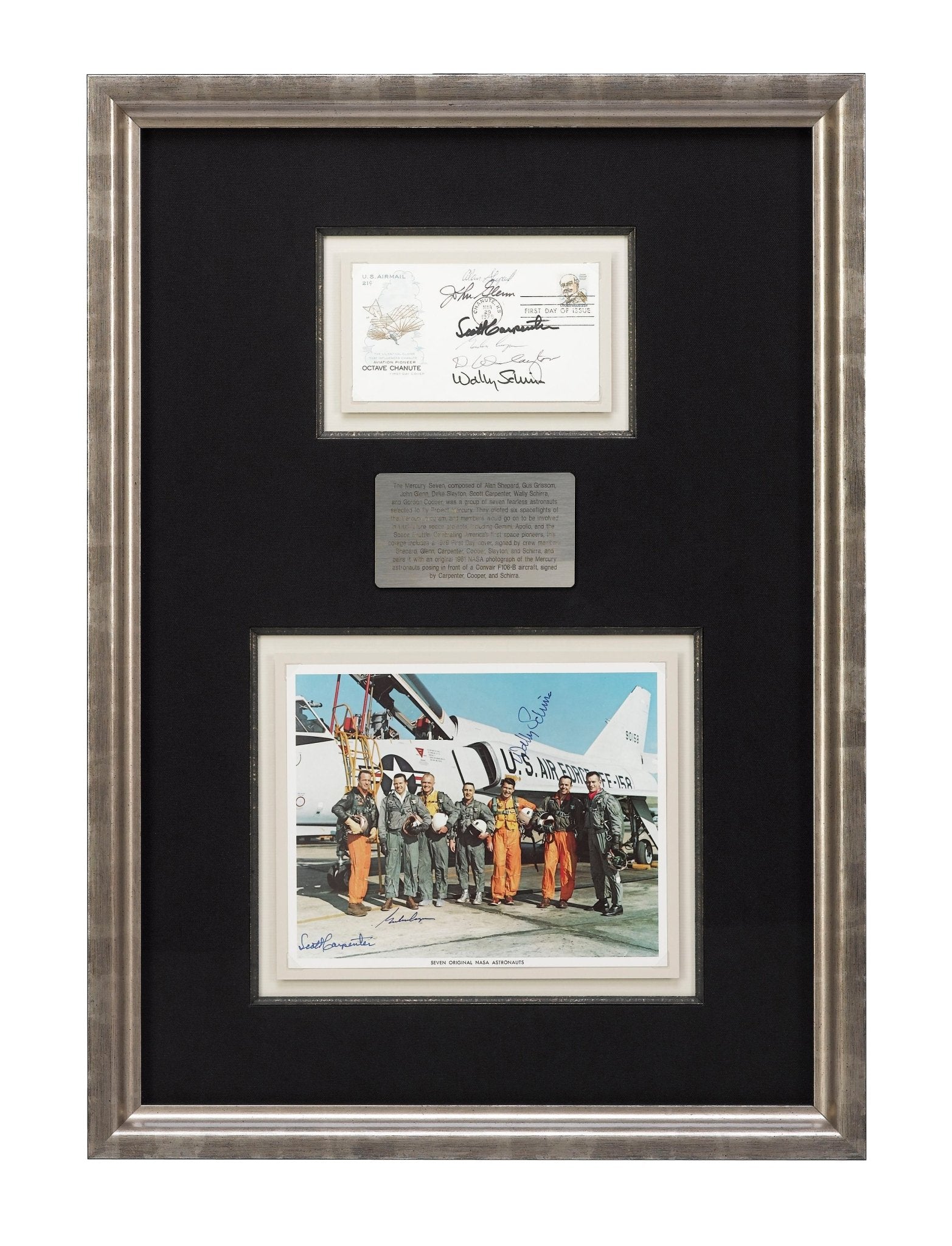
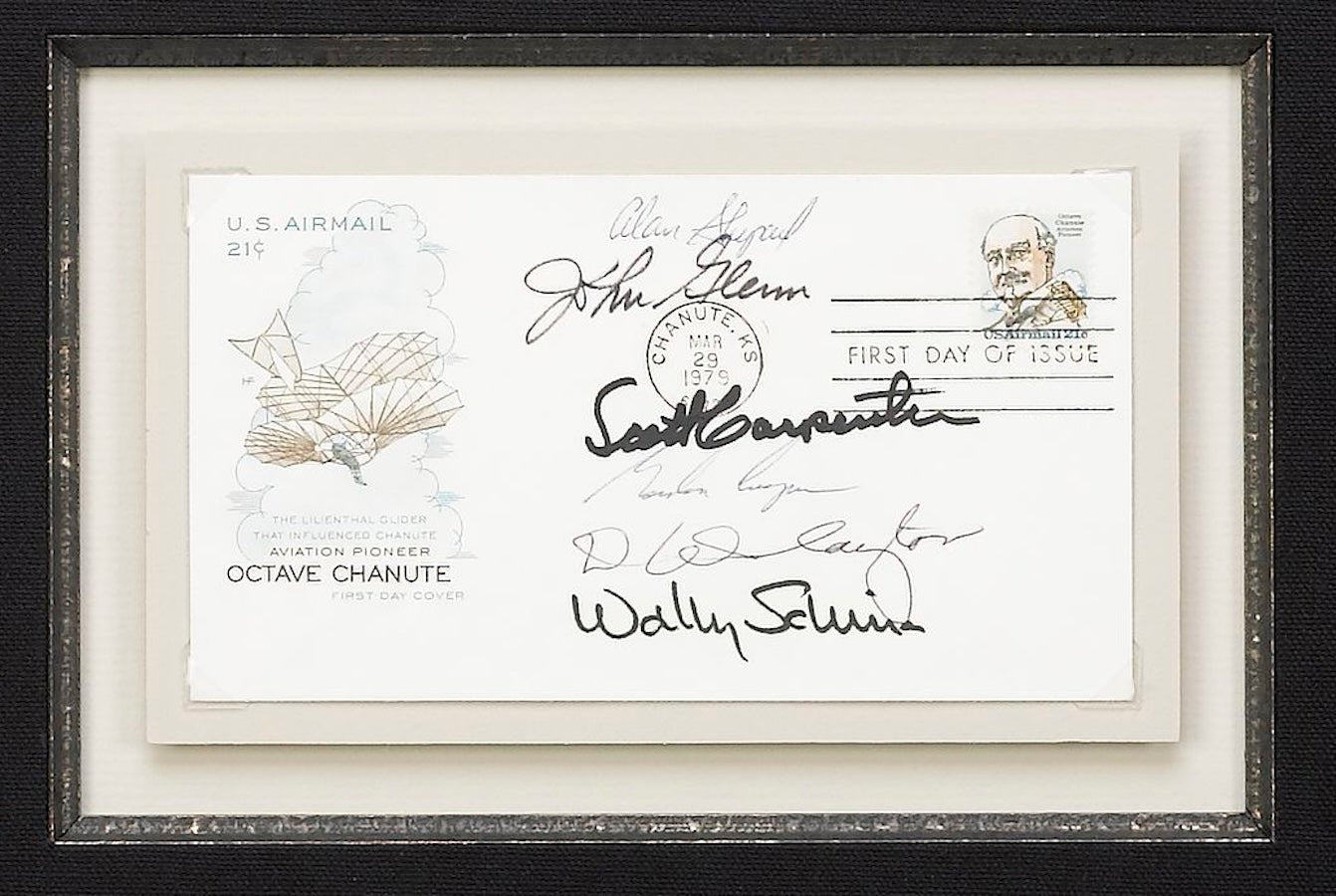
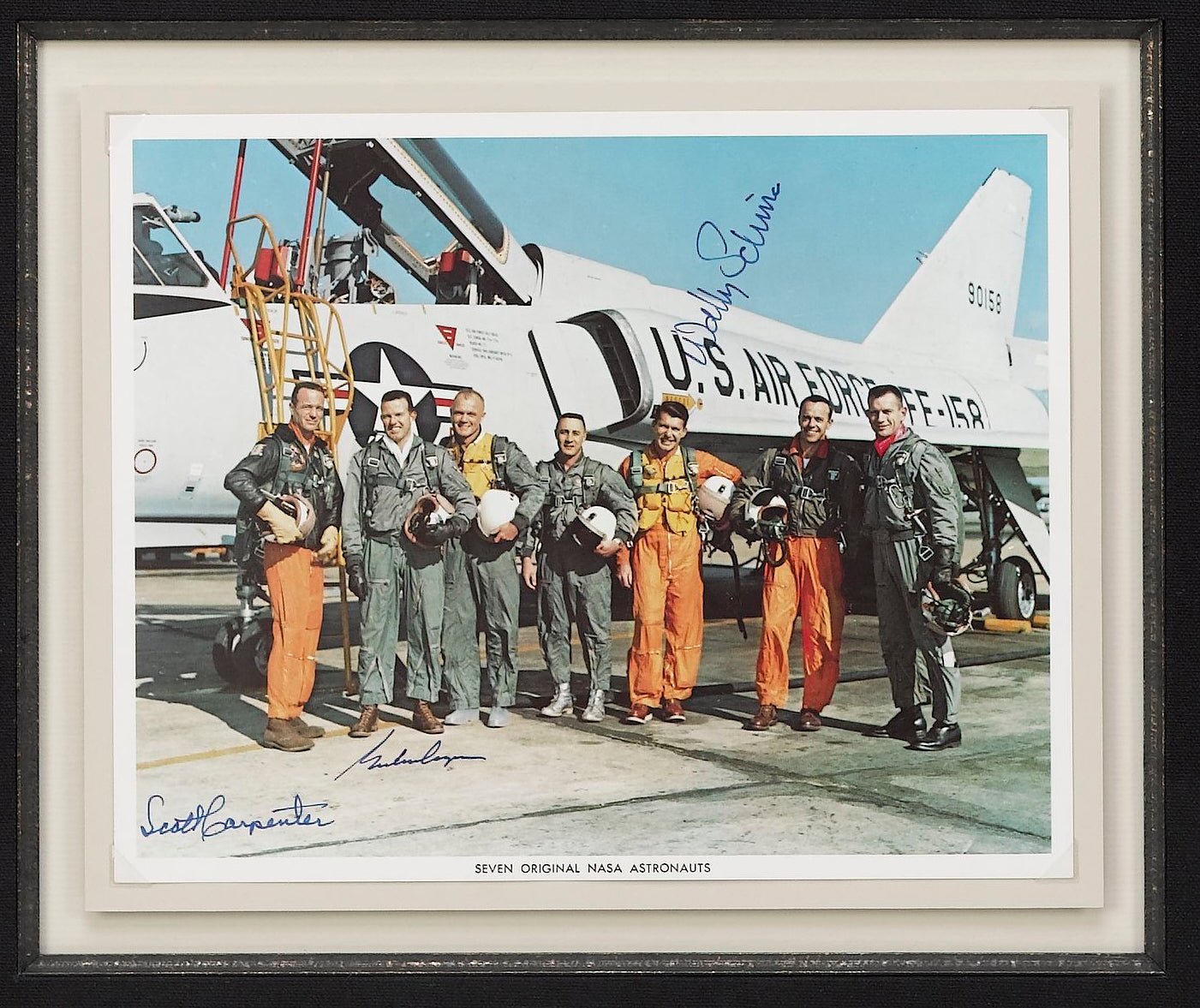
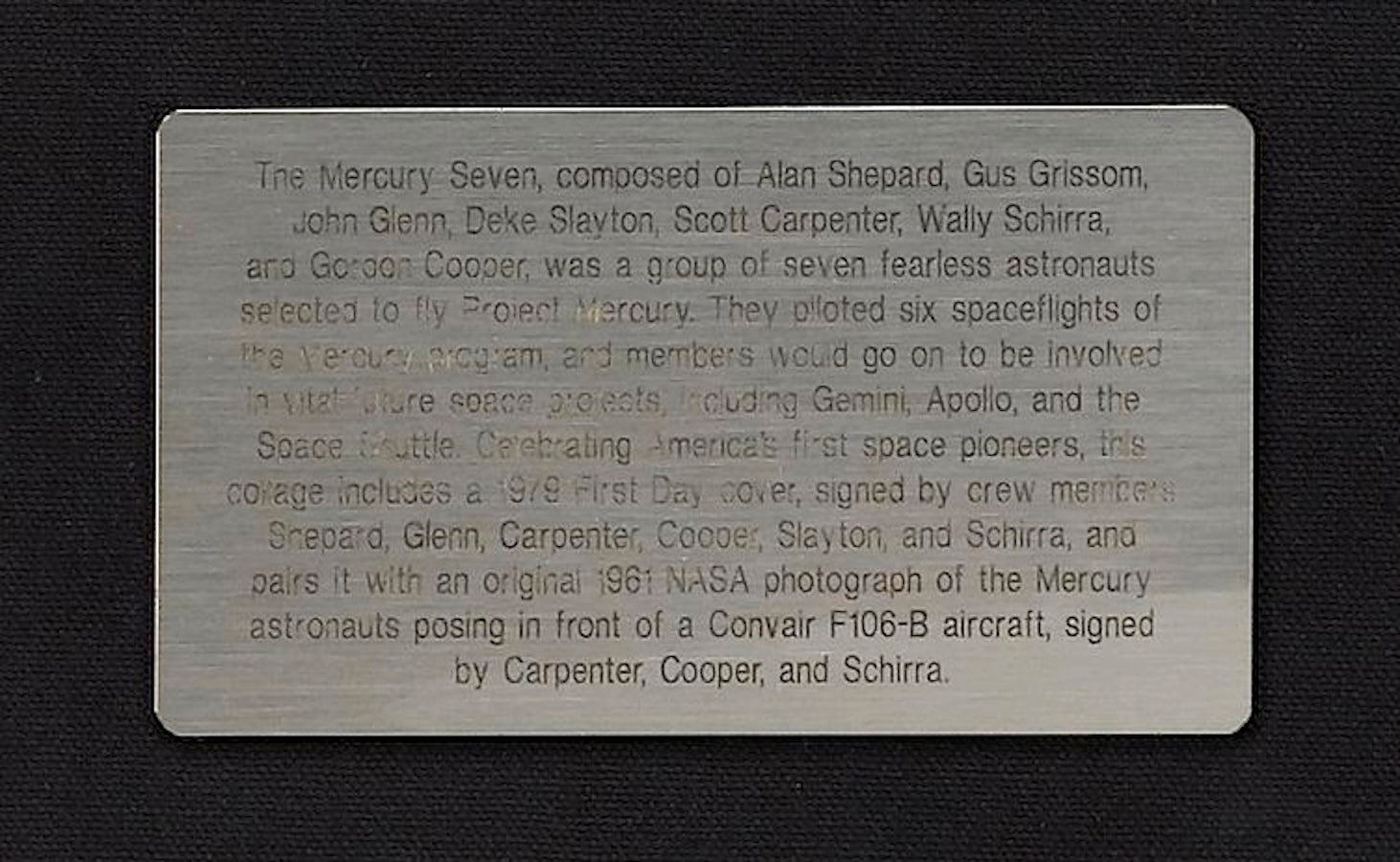
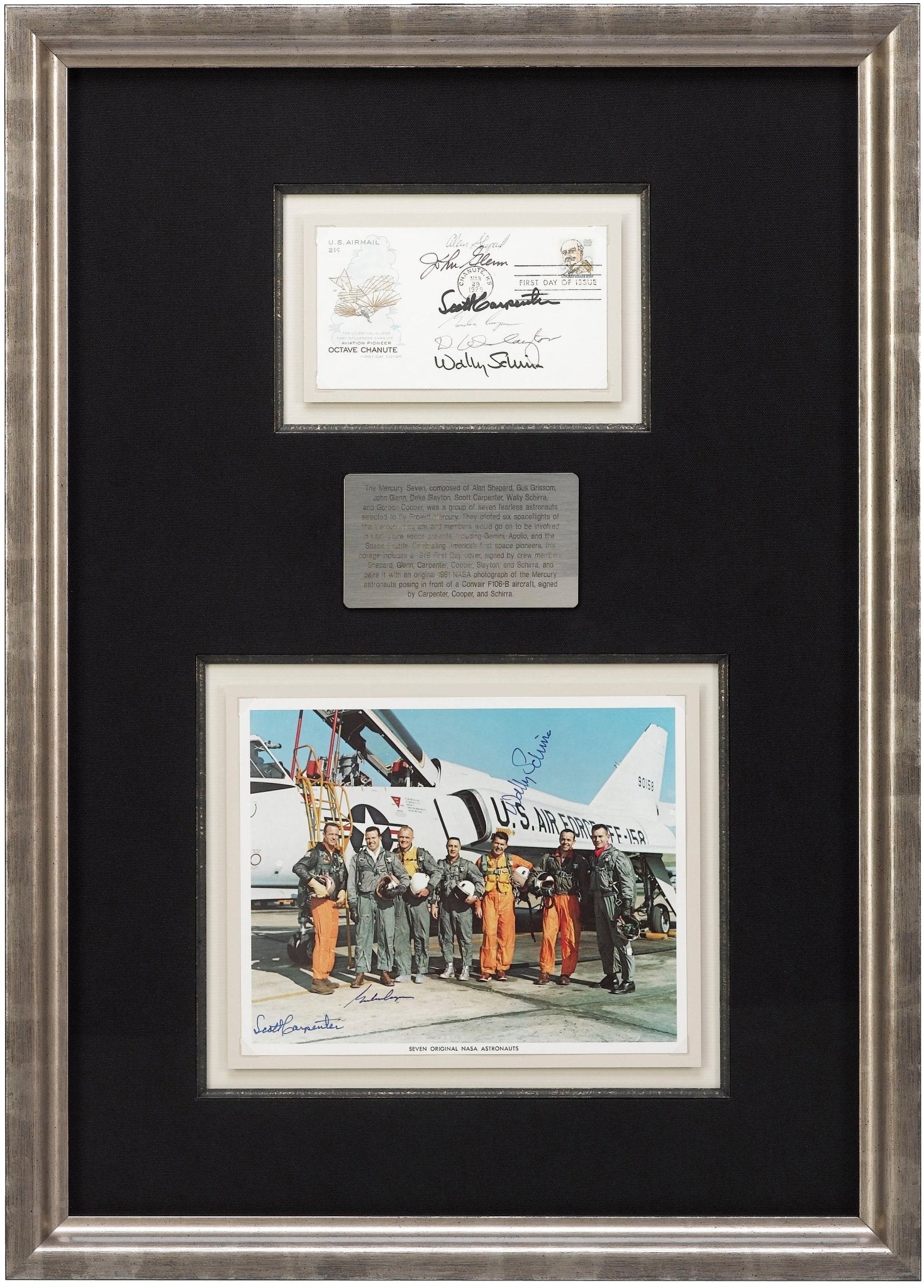
Mercury Seven Signature Collage
The Mercury Seven, composed of Alan Shepard, Gus Grissom, John Glenn, Deke Slayton, Scott Carpenter, Wally Schirra, and Gordon Cooper, was a group of seven fearless astronauts selected to fly Project Mercury. They piloted six spaceflights of the Mercury program, and members would go on to be involved in vital future space projects, including Gemini, Apollo, and the Space Shuttle. Celebrating America's first space pioneers, this collage includes an original 1961 NASA photograph of the Mercury astronauts posing in front of a Convair F106-B aircraft, signed by Carpenter, Cooper, and Schirra, and pairs it with a 1979 First Day Cover, signed by crew members Shepard, Glenn, Carpenter, Cooper, Slayton, and Schirra. The missing crew member signature belongs to Gus Grissom, who tragically died in the 1967 Apollo 1 fire.
On April 9, 1959, NASA formally introduced the nation to its seven Mercury astronauts. Convened at the Dolley Madison House in Washington, DC, which served as the first headquarters of the new space agency, the seven test-pilots-turned-astronauts were introduced by NASA Administrator T. Keith Glennan in alphabetical order: “Malcolm S. Carpenter, Leroy G. Cooper, John H. Glenn, Virgil I. Grissom, Walter M. Schirra, Alan B. Shepard, and Donald K. Slayton … the nation’s Mercury astronauts!” The term was a cross between "aeronauts," as ballooning pioneers were called, and "Argonauts," the legendary Greeks in search of the Golden Fleece. These new explorers were being prepared to sail into the new, uncharted vastness of space. Spurred on by the Soviet Union’s rapid technological advancement, the project’s objectives were to orbit a manned spacecraft around the Earth, investigate man’s ability to function in space, and recover both man and spacecraft safely back to Earth.
The Mercury 7 astronauts went on to have stellar careers in the space program. With the exception of Slayton, who was grounded by a heart murmur, all flew pioneering Mercury missions between 1961 and 1963. In 1975, Slayton was reinstated and flew on the Apollo-Soyuz Test Project, a joint American-Soviet space flight, becoming the last of the original group to fly in space. Carpenter made his single trip into space during the three-orbit Mercury 7 flight. Cooper flew the longest Mercury mission in 1963 and two years later went on to fly on the then record-breaking eight-day Gemini 5 flight.
Glenn became the first American to orbit the Earth in 1962 and returned to space in 1998 during Space Shuttle Discovery’s STS-95 mission. Grissom flew the second suborbital Mercury mission in 1961, the first Gemini mission in 1965, and was designated to command the first Apollo mission when he died in a fire during a launch pad training exercise. Schirra was the only person to fly Mercury, Gemini, and Apollo missions, accomplishing the first rendezvous and commanding the first crewed Apollo flight. After becoming the first American in space in 1961, Shepard eventually became the only one of the Mercury 7 to walk on the Moon, during Apollo 14.
CONDITION:
Mercury Seven "Octave Chanute" First Day Cover: A U.S. Air Mail 21 cent first day cover, honoring French-American aviator, Octave Chanute. Postmarked in Chanute, Kansas, and dated March 29, 1979. Signed by crew members Alan Shepard, John Glenn, Scott Carpenter, Gordon Cooper, Deke Slayton, and Wally Schirra in blue and black ink. With bold signatures, very fine. Dimensions: 3 1/2” H x 6 1/2” W.
Signed Photograph of Mercury Astronauts: Official color NASA lithograph of the original Mercury astronauts posing in front of a Convair F106-B aircraft at Langley Air Force Base on January 20, 1961. Signed in blue felt tip by Scott Carpenter, Gordon Cooper, and Wally Schirra. In fine condition. Dimensions: 8” H x 10” W.
The signed First Day Cover and signed Photograph are archivally mounted and framed together, with acid-free grey and black linen mats, UV conservation clear glass, a descriptive metal plaque, and a custom silver wooden frame.
Framed Dimensions: 28 1/2"H x 20 1/2"W x 1 7/8"D.
Accompanied by our company’s letter of authenticity.
Pickup available at Colorado
Usually ready in 4 hours

Mercury Seven Signature Collage
Colorado
1 Lake Avenue
Colorado Springs CO 80906
United States
Choose options





Frequently Asked Questions
FAQs
Yes, all of our Antiques are certified authentic. Every antique comes with a signed Letter of Authenticity that details the item’s history, its current condition including any conservation, binding, or framing work, and the item’s provenance. The Letters of Authenticity are priced valuations by our authentication specialists, who assure that items are original and unconditionally guaranteed as genuine for life.
We pack and ship your items from our gallery in Colorado Springs. You may also choose to come pick up your order. Antique items are carefully packed and insured during shipping. The shipping price will be calculated at checkout.
We acquire from a variety of trusted sources all over the world, but mostly through auctions and private collections within the United States. All provenance information will be listed on the Letter of
Authenticity accompanying your purchase.

